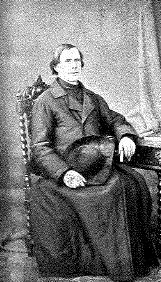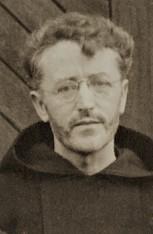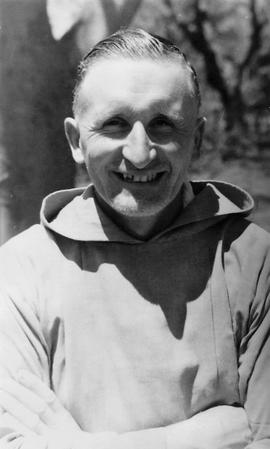John McNamara was born in Glin, County Limerick, on 10 September 1931. He was baptised in the Immaculate Conception Parish Church in Glin in the Diocese of Limerick. He attended the national school in Glin after which he received his secondary education at Rochestown College in County Cork. He was admitted to the Capuchin novitiate in Rochestown on 3 October 1950. Following his temporary profession in Rochestown a year later, he was transferred to St. Bonaventure’s Friary in Cork from where he attended University College Cork for three years, after which he was conferred with a Bachelor of Arts degree. He made his perpetual profession in St. Bonaventure’s on 4 October 1954 and then made his way to Ard Mhuire Friary in Donegal for theological studies. He was ordained to the priesthood by William McNeely, Bishop of Raphoe, in St. Eunan’s Cathedral in Letterkenny on 15 May 1958. Later that year, he commenced Canon Law studies in Rome and obtained a Licentiate in 1960. On 17 August 1960, Fr. Donatus departed for the Irish Capuchin mission in Northern Rhodesia (now Zambia). He first served as assistant pastor in St Therese’s and in Maramba, both in the Livingstone Diocese, from 1960 to 1963. He then went on to teach seminarians in St. John’s in Mongu, in Limulunga and in Nalionwa (Kalabo) from 1964 to 1978. He was rector of the school at Limulunga from 1965 to 1978. He returned to Ireland in 1978, when he became a member of the staff at Rochestown College, teaching there for the next ten years. In 1988 he was appointed Mission Secretary and worked out of the mission office at the Church Street Friary in Dublin. In 1998, he returned to Zambia. He was posted to Malengwa Friary in Mongu, the capital of the Western Province in Zambia, and was appointed chaplain to Mongu Teacher Training College. After a two-year stay (2008-10), in St. Pio Friary, Fr. Donatus was transferred to the recently built Capuchin novitiate at the Camerino Friary in Lusaka, where he lived until his death on 5 July 2021. He was buried in the cemetery attached to the Camerino Friary.
Baptismal name: John McNamara
Religious name: Fr. Donatus McNamara OFM Cap.
Date of birth: 10 Sept. 1931
Place of birth: Glin, County Limerick
Name of father: Thomas McNamara
Name of mother: Brigid McNamara (née Egan)
Date of reception into the Capuchin Order: 3 Oct. 1950
Date of first profession: 4 Oct. 1951
Date of final profession: 4 Oct. 1954
Date of ordination (as priest): 15 May 1958
Educational attainments: BA, 2nd class hons. (1954); Licentiate in Canon Law, Rome (1960)
Missionary activities: Travelled to Livingstone, Northern Rhodesia (later Zambia), on 17 Aug. 1960. He returned to Ireland on 10 Aug. 1976. He returned to Zambia in Sept. 1998.
Date of death: 5 July 2021
Place of death: St. Clare’s Hospital, Makeni, Lusaka, Zambia
Place of burial: Cemetery, Capuchin Novitiate, Camerino Friary, Lusaka, Zambia
Thomas McNamara was Provincial of the Irish Vincentian Province 1864-1867. He was President of Castleknock College for the same three years.
Here is an article which was published by Gary Culliton in the Irish Medical Times about Father McNamara's being 'solely or partly responsible for the founding of a large number of Dublin medical institutions':
https://www.knockunion.ie/news/thomas-mcnamara-cm-svc-president-1864-67-9763
Buried in Castleknock: https://www.findagrave.com/memorial/259983682/thomas-mcnamara_cm
Baptismal name: Leo McKnight
Religious name: Fr. Bruno McKnight OFM Cap.
Date of birth: 14 July 1929
Place of birth: Kilkeel, County Down (Diocese of Down and Connor)
Name of father: Thomas McKnight
Name of mother: Elizabeth McKnight (née Hughes)
Date of reception into the Capuchin Order: 3 Oct. 1949
Date of first profession: 4 Oct. 1950
Date of final profession: 4 Oct. 1953
Date of ordination (as priest): 30 May 1957
Educational attainments: BA (1953)
Missionary activities: Travelled to Livingstone, Northern Rhodesia (later Zambia), on 5 Nov. 1957; Zambian Mission Custody Consultor, from 1973-6, 1976-9; Regular Superior of the Zambian Mission Custody from 1979-85.
Date of death: 21 Dec. 2012
Place of death: Our Lady’s Hospice, Harold’s Cross, Dublin
Place of burial: Dardistown Cemetery, Dublin
Baptismal name: Thomas McKenna
Religious name: Fr. Damascene McKenna OFM Cap.
Date of birth: 20 Mar. 1913
Place of birth: Londonbridge Road, Sandymount, Dublin
Name of father: Patrick McKenna
Name of mother: Sarah McKenna (née Moran)
Date of reception into the Capuchin Order: 15 Nov. 1931
Date of first profession: 16 Nov. 1932
Date of final profession: 16 Nov. 1935
Date of ordination (as priest): 18 June 1939
Educational attainments: BA (1935)
Missionary activities: Travelled to Barotseland, Northern Rhodesia on 12 Sept. 1939. He was later a missionary in Cape Town, South Africa.
Date of death: 17 Sept. 1967
Place of death: Cape Town, South Africa
Place of burial: Maitland Cemetery, Cape Town, South Africa
Baptismal name: Patrick McGirr
Religious name: Fr. Macartan McGirr OFM Cap.
Date of birth: 4 May 1894
Place of birth: Ballygawley, County Tyrone
Name of father: Henry McGirr (Farmer)
Name of mother: Isabella McGirr (née Montague)
Date of reception into the Capuchin Order: 27 Aug. 1914
Date of first profession: 15 Oct. 1915
Date of final profession: 15 Oct. 1918
Date of ordination (as priest): 29 June 1923
Educational attainments: BA (1919)
Date of death: 31 Oct. 1954
Place of death: Capuchin Hostel, Raheny, County Dublin
Place of burial: Glasnevin Cemetery, Dublin
Eugene McGillicuddy was born in Cork on 8 September 1901. An enthusiastic and prominent member of the Third Order of St. Francis confraternity in his native city, he entered the Capuchin novitiate in April 1939 and took Gabriel as his religious name. After his profession, he was for some years a member of the Ard Mhuire community in County Donegal. He subsequently volunteered for the African missions and arrived in Northern Rhodesia (now Zambia) in February 1946. Br. Gabriel initially worked in Mukunkiki with Fr. Aquinas Carroll OFM Cap. and Fr. Salvator Quinn OFM Cap. In 1948, a decision was taken to move this mission to Mangango, located about thirty kilometres distant, and Br. Gabriel enjoyed a long association with this locality. He was particularly involved in the construction of mission churches, hospitals, and schools. In 1959, Fr. Bruno McKnight OFM Cap. and Br. Gabriel began work on the church of Saint Michael the Archangel and adjoining school at Nalionwa. This work was completed in 1960. He also supervised the construction of Saint John’s Secondary School in Katongo (1962) and Holy Cross Secondary School in Malengwa (1964). Br. Gabriel returned to Ireland in July 1983. He died at Ard Mhuire Capuchin Friary in County Donegal on 7 July 1998 and was buried in the adjoining cemetery.
Baptismal name: Eugene Joseph McGillicuddy
Religious name: Br. Gabriel McGillicuddy OFM Cap.
Date of birth: 8 Sept. 1901
Place of birth: 5 King’s Terrace, Cork
Name of father: Daniel McGillicuddy (Grocer)
Name of mother: Ellen McGillicuddy (née Molyneaux)
Date of reception into the Capuchin Order: 21 Apr. 1939
Date of first profession: 22 Apr. 1940
Date of final profession: 4 Oct. 1943
Missionary activities: Travelled to Barotseland, Northern Rhodesia (later Zambia), on 21 Feb. 1946. He returned to Ireland on 21 July 1983.
Date of death: 8 July 1998
Place of death: Ard Mhuire Friary, County Donegal
Place of burial: Cemetery, Ard Mhuire Friary, County Donegal
Baptismal name: Alphonsus McGarry
Religious name: Fr. Columban McGarry OFM Cap.
Place of birth: Rasharkin, County Antrim (Diocese of Down & Connor)
Date of birth: 20 April 1901
Name of father: Patrick McGarry
Name of mother: M.A. McGarry (née Cleland)
Date of reception into Capuchin Order: 18 September 1921
Date of first profession: 15 October 1922
Date of final profession: 22 December 1925
Date of ordination (Rome): 29 July 1928
Education: BA (1st class honours): 1925; Doctorate in Divinity, 1929 (Rome); Licentiate of Sacred Scripture, 1931 (Rome).
Ministries: Spiritual Director of the Pontifical Ethiopian College at the Vatican from 1966-70; Guardian of St. Fidelis Hospice, Rome, from 1970-5; returned to Ireland in 1975 and was appointed to the Church Street community in Dublin.
Date of death: 24 December 1987
Place of death: Fahan Nursing Home, County Donegal
Place of burial: Cemetery, Ard Mhuire Capuchin Friary, County Donegal
Daniel McFadden was born in Belfast on 4 March 1901. He joined the Capuchin Franciscans in September 1918 and took Declan as his religious name. Following his theological studies, he was ordained to the priesthood in June 1927 and spent his first years in ministry in Holy Trinity Church in Cork. He was among the first friars to volunteer for the Irish Capuchin mission in Cape Town, South Africa (1929), and two years later (October 1931) in the newly established mission territory in Livingstone and Barotseland in Northern Rhodesia (now Zambia). He arrived in Barotseland in 1931 and immediately began to journey (on foot) to remote areas around Sesheke and further afield in Mongu in the western part of the country. Illness brought on by exposure to tropical diseases forced him to return to Ireland in April 1933. He once again volunteered for missionary work in the late 1930s and he made his way to the Archdiocese of Delhi-Simla in India. The Irish Capuchin friar, Fr. Sylvester Mulligan OFM Cap., had been appointed archbishop of this diocese in 1937. Fr. Declan remained in India for eleven years (1937-48). Following his return to Ireland, he was assigned to the Rochestown community in County Cork. Aside from a brief, three-year stint in Kilkenny, he remained in Rochestown for the rest of his life. His ministry included acting as spiritual director for the local Third Order of St. Francis confraternity, organising the church choir, and regular pastoral, preaching, confession, and mission duties. He died on 30 November 1979 and was buried in the cemetery attached to Rochestown Friary.
Baptismal name: Daniel McFadden
Religious name: Fr. Declan McFadden OFM Cap.
Date of birth: 4 Mar. 1901
Place of birth: Limestone Road, Belfast (Diocese of Down and Connor)
Name of father: Daniel McFadden
Name of mother: Mary Ann McFadden (née Burrell)
Date of reception into the Capuchin Order: 29 Sept. 1918
Date of first profession: 4 Oct. 1919
Date of final profession: 4 Oct. 1922
Date of ordination (as priest): 29 June 1927
Academic attainments: BA (1923)
Mission activities: Travelled to Cape Town, South Africa, and later Northern Rhodesia (now Zambia), in 1929. He returned to Ireland from Africa in 1933. He travelled to India in 1937. He returned to Ireland in 1948.
Date of Death: 30 Nov. 1979
Place of death: Cork
Place of burial: Cemetery, Rochestown Capuchin Friary, County Cork
Francis McDonnell was born in the town of Carrigaline in County Cork in 1872. He joined the Capuchin Franciscans in September 1889 and took Mark as his religious name. He was ordained to the priesthood on 2 July 1896. Shortly after his ordination, he took charge of the Catholic Boys’ Brigade on Church Street in Dublin. Following the Provincial Chapter of 1904, he was appointed guardian (local superior) of the Capuchin community in Kilkenny. He subsequently returned to Dublin and served as guardian of the Church Street Friary from 1919 to 1922. He was twice elected Provincial Definitor (councillor), from 1922-5 and from 1925-8. He was an active member of the Capuchin missionary staff and was well known as a preacher and retreat giver throughout the country. He died in Dublin on 12 June 1947 and was buried in Glasnevin Cemetery.
Baptismal name: Francis McDonnell
Religious name: Fr. Mark McDonnell OFM Cap.
Date of birth: c.31 Mar. 1872
Place of birth: Carrigaline, County Cork
Name of father: John McDonnell
Name of mother: Margaret McDonnell (née Riordan)
Date of reception into the Capuchin Order: 8 Sept. 1889
Date of first profession: 1 Jan. 1891
Date of final profession: 9 June 1895
Date of ordination (as priest): 2 July 1896
Leadership positions: Provincial Definitor (Councillor), 1922-5, 1925-8
Date of death: 12 June 1947
Place of death: Jervis Street Nursing Home, Dublin
Place of burial: Glasnevin Cemetery, Dublin








